AMD processors use different sockets than Intel-supplied models. Therefore, the choice of the processor itself is so important - it defines a set of additional components, like a motherboard, and at the same time can tie the user to one platform.
This is a connector designed for new group Phenom II processors, as well as Athlon II, Sempron and Opteron. Entered the market in 2009. The most important change was the introduction of support for the DDR3 memory controller. AM3s are not compatible with older versions, even though the design difference is just the addition of a single pin.
socket AM3+
The AM3+ socket is a new, modified version of its predecessor (AM3), prepared with AMD Bulldozer architecture-based processors in mind. Unlike most Intel stands, the AM3+ is AM3 compatible, which means processors based on new socket can be installed in socket AM3. The only condition is a BIOS update if the manufacturer decides to release it new version. However, keep in mind that not every processor will work in an AM3 package. Among the design differences, you can specify the addition of one contact. The new stand also introduces improved power regulation.
The processor families that can be installed in the AM3+ socket are Phenom II, Athlon II, and FX.
IN motherboards ah socektem AM3+ also introduced new 990FX and SB950 logic chips, which provide support for octa-core processors. Support for HyperTransport technology version 3.1 has also been added. In addition, the first of them introduces the possibility of combining video cards in SLI.
Asus M5A78L-M/USB3 AMD 760G mATX - (M5A78L-M/USB3)
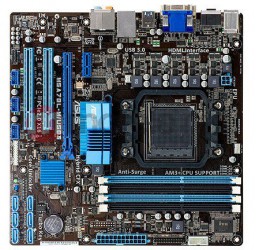
- Motherboard standard: Micro-ATX
- Chipset: AMD 760G, AMD SB710
- Processor socket: socket AM3+
- Integrated video card: Yes
Company AMD introduced the second generation of desktop APUs. chips Trinity are based on the improved Piledriver architecture and also have a powerful integrated video core. Mobile versions new generation processors from AMD have been offered as part of laptops for almost half a year. An attractive combination of consumer parameters allowed the company to increase its share in this segment. Let's see if the desktop versions of Trinity, designed for the new platform, will be so successful Socket FM2.
APU Trinity
What are the new hybrid processors codenamed Trinity? In the maximum configuration, these chips include a quad-core x86 computing unit with the most advanced AMD architecture at the moment - Piledriver. This further development Bulldozer architecture, which is used for the fastest AMD FX series chips. In addition, a graphics core is placed on the chip, which the manufacturer refers to the Radeon HD 7000 series.
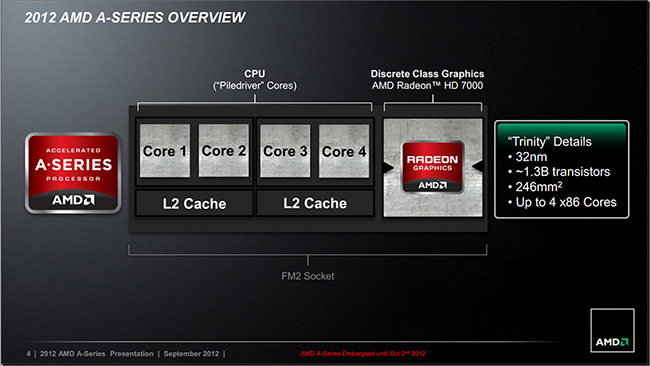
Trinity, although they are the successors of the Llano processors, however, there is practically nothing left in common between them. Both the computing part and the graphics part in this case are not just improved, they are fundamentally different. Perhaps the only thing that connects the APU of both generations is the 32-nanometer process technology, which is also used for Trinity. Of course, a more advanced technical process would be preferable here, but the production facilities of GlobalFoundries are not yet ready for the mass production of chips using technology thinner than 32 nm.
Trinity's die area is 246 mm² and contains 1.3 billion transistors, while the Llano chip's silicon wafer is 228 mm² and carries 1.18 billion transistors (after a recent update by the manufacturer). The packing density remained about the same, the area increased by about 8%, while the number of semiconductors increased by 10%. Given the timing of the development of the 32-nanometer process technology, we assume that the cost of production of crystals, if increased, then only slightly.

What's new in Trinity? The dual-channel DDR3 memory controller officially supports operation in modes up to DDR3-1866, while it also became possible to use modules with a reduced supply voltage (1.25 V). As you can see, almost half of the crystal is occupied by the graphic part. The integrated GPU has an architecture inherent in chips for discrete adapters of the family Northern Islands. An important innovation is the AMD HD Media Accelerator video encoding/decoding unit. Functions north bridge chipset, of course, is now integrated into the processor. In terms of computing power, Trinity has a couple of dual-core x86 modules. Within each of them, the cores are partially dependent, as they use some common resources, in particular, instruction prefetch and processing blocks. real numbers(FP). Each module has a dedicated 2 MB L2 cache segment. L3 cache memory is not provided here - this is the prerogative of the CPU AMD series fx. For communication with external devices, the processor has at its disposal 24 PCI Express lanes. Note the support for HDMI, DisplayPort 1.2 and DVI interfaces.
Trinity processors initially operate at fairly high clock speeds. If Llano chips have just approached the 3 GHz bar, then the older model from the new APU family normally operates at 3.8 GHz, with the ability to accelerate up to 4.2 GHz. Trinity received the latest modification of the dynamic auto-acceleration mechanism AMD Turbo Core 3.0, which, depending on the nature of the load, can automatically increase the frequency of the CPU. Each processor model has its own range: from 200 to 600 MHz.
Integrated graphics
Introducing the term APU(Accelerated Processing Unit), the company initially wanted to emphasize the importance of the integrated graphics unit. Integrated graphics core Trinity, dubbed Devastator, uses architecture VLIW4, which was used for the Radeon HD 6900 of the Northern Islands family. Obviously, the developers have not yet been able to optimize the new GCN (Graphics Core Next) architecture for the needs of the APU, which is used in GPUs for discrete graphics cards of the Radeon HD 7000 series.
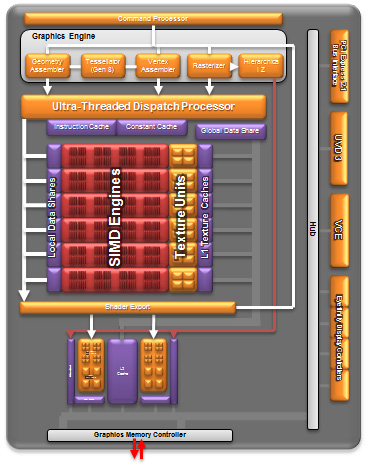
Recall that the graphics part of the Llano chips has the VLIW5 architecture. The computing units it includes can theoretically perform more operations in parallel than those with VLIW4. However, in real tasks the latter are more efficient. In addition, VLIW4 stream processors, all other things being equal, can operate at a higher clock frequency. It is quite difficult to draw parallels here, but some quantitative indicators are curious. IN full version the Llano graphics core contains 400 computing units, while the Trinity GPU has 384, but in the latter case, the nominal operating frequency of the graphics unit is 800 MHz, while the predecessor has 600 MHz.
The Devastator core includes 24 texture units and 8 rasterizers. AMD emphasizes that in this case the tessellation processing unit is noticeably accelerated. A hardware block is allocated for working with video data AMD HD Media Accelerator, which includes the most advanced UVD3 video decoding module inherited from the Radeon HD 6000/7000 processor. In addition, the processor contains the AMD Accelerated Video Converter video transcoding unit. Functionally, it is similar to Quick Sync, which Intel uses in its processors.
In general, the Trinity graphics core has excellent functionality. It boasts full support for DirectX 11 with Shader Model 5.0, OpenCL 1.1 and DirectCompute 11. At the same time, the new APUs allow you to connect up to four independent display devices, moreover, support for Eyefinity technology is also announced. Also noteworthy is the support AMD Steady Video 2.0, which allows you to improve the quality of your video by helping to eliminate the effect of shaky images during handheld shooting.
Like its predecessors, Trinity processors have the ability to operate in Dual Graphics, combining the efforts of an integrated GPU with a discrete graphics card. However, in this case, we are still talking about devices entry level from the Radeon HD 6500/6600 lines.
The manufacturer recommends using the Radeon HD 6670 to help the A10 chips, the Radeon HD 6570 is offered for the A8 and A6, while the HD 6450 is offered for the A4. a potential owner of a Socket FM2 system already has a video card that can be used as an additional accelerator. The intentional purchase of an adapter of the required class for use in Dual Graphics mode, although it has the right to exist as a deferred upgrade option, however, in general, it loses to the idea of acquiring a faster graphics adapter, which will cost a little more, but in games it will be noticeably more productive than the proposed bundle.
Piledriver architecture
The Piledriver architecture is an upgraded version of the Bulldozer used for the Zambezi (AM3+) chips.
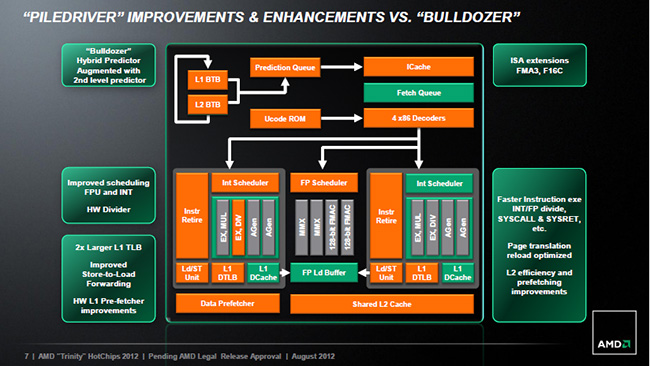
Branch prediction blocks, data prefetching have been improved, the efficiency of working with the second-level cache has been increased, the L1 TLB size has been increased, and the work of the INT and FP module load scheduler has also been improved. In addition, the new F16C instruction sets are now supported, as well as FMA3, which Intel plans to add to its Haswell chips. AVX kits are now available for new APUs, which were not supported by Llano chips. In general, Piledriver does not fundamentally differ from the Bulldozer architecture, it is a modified version with a number of improvements and cosmetic optimizations.
APU Trinity range
At the time of the launch of the new platform, the line of chips Trinity includes six models. Two quad-core processors A10 and A8, and one each A6 and A4. As you can see, the number of x86 blocks is not reflected in the name of the APU series. At the same time, there is a dependence of the chip belonging to one or another line, which is determined by the number of computing cores of integrated graphics: A10 - 384, A8 - 256, A6 - 192, A4 - 128. This is another clear example of how the manufacturer wants emphasize the importance of the graphic component.
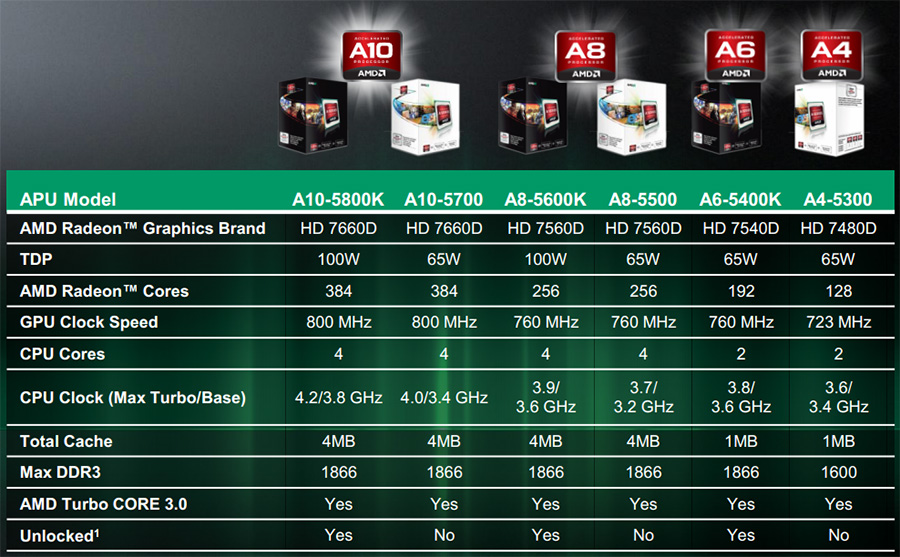
Line flagship - A10–5800K– operates at 3.8 / 4.2 GHz, its integrated GPU contains 384 computers and operates at 800 MHz. The L2 cache is 4MB and the claimed power consumption is 100W. The second "ten" has the same characteristics, except for the frequency formula. For A10-5700 the base ones are 3.4 GHz, and the dynamic auto-overclocking limit is 4 GHz. This was enough to bring the TDP down to 65W. In A8 models, in addition to a reduced number of video core processing units from 384 to 256, its operating frequency is also reduced to 760 MHz. Formulas for x86 blocks: A8-5600K– 3.6/3.9 GHz, A8-5500– 3.6/3.8 GHz. Single-module A6 and A4 chips, in addition to losing two x86 blocks, have a common L2 cache of only 1 MB. Quantity GPUs reduced to 196 in case of A6-5400K, and up to 128 - at A4-5300.
As for the cost of the new APUs, the Trinity chips actually play in the same price segment as their predecessors - $50-130. At the same time, the pricing system is interesting. Both A10s are priced at $122. Both the model with an unlocked multiplier and the chip with a lower multiplier have the same recommended cost. clock frequency and a blocked KU, which nevertheless has a TDP of 65 W, instead of 100 W for the flagship. The situation is exactly the same with the A8 line of APUs - both models are offered at the same price of $101. For someone has more value high performance, someone prefers more economical options. And for those and for others, suitable processors will cost the same price.
As is the case with Llano processors, as well as devices from a competitor, models with the “K” index have an unlocked multiplier. Curiously, now the most affordable model with this feature costs only $67, while the price of the previous generation APU with a free multiplier started at $80. However, the A6-3670K is a quad-core model, while the A6-5400K only has one module with a couple of dependent modules.
For Socket FM2, processors with a disabled graphics core will also be available, which will complete the line of Athlon chips. Given the general concept of APU, it is obvious that separate crystals will not be produced for such models (although, given the area occupied by the GPU, this would make sense), for such processors chips will be used first of all, with certain problems in the graphic part, and if there are fewer of them than the market requires, then full-fledged crystals with a deactivated GPU will also be used.
Socket FM1 and Socket FM2 compatibility
Unfortunately for the owners of systems with hybrid chips of the first wave, the new APUs are neither forward nor backward compatible with the Socket FM1 platform. The processor socket, and, accordingly, the pins on the chip visually have a minimal difference (905 vs. 904), but a different arrangement of the "keys" does not even allow installing Trinity in the old socket.
 (left - APU Trinity, right - APU Llano)
(left - APU Trinity, right - APU Llano)
AMD for quite a long time gave evasive answers to questions about the compatibility of FM2 and FM1 sockets, so as not to indirectly reduce the demand for processors for the latter. Now this is not necessary. Given that the new APUs are fundamentally different from their predecessors at the level of architectures, it is not surprising that they have their own power subsystem features that were not taken into account in Socket FM1. It was this fact that forced AMD to change the platform.
Chipsets
Despite the fact that Socket FM1 and Socket FM2 are incompatible with each other, the chipsets used on the previous generation platforms are quite suitable for the new one. chips AMD A55, and AMD A75 we will see in the composition of motherboards for Socket FM2. In general, there is nothing to be surprised here. Given the fact that key features chipsets are taken over by central processors, their role in modern platforms is largely reduced to servicing peripherals. And here innovation does not happen so often. If there are already certain complaints about the functionality of the AMD A55 (lack of SATA 6 Gb / s), then the AMD A75 cannot be called obsolete. The latter became the first chipset in the industry with an integrated native USB 3.0 controller. And the rest of the "kit" is quite on the level.

To make the announcement of Socket FM2 even brighter, AMD also introduced a new chipset that will be used for this platform - AMD A85X. One of its key differences from the A75 is the ability to split the PCI-E x16 bus into two devices (x8 + x8), and, as a result, the ability to create CrossFire configurations with a pair of discrete video cards. In addition, the A85X now supports 8 instead of 6 SATA 6 Gb/s ports and allows you to create RAID 5 disk arrays. It also provides FIS-Based Switching channelization capabilities. No changes regarding USB bus support and configuration: 4 USB port 3.0, up to 10 USB 2.0 ports and up to two USB 1.1 ports.
The Socket FM1 platform did not provide the ability to use two graphics adapters in the system. Such configurations are the lot of rather enthusiastic gamers or experienced crunchers. Obviously, in the case of Socket FM2, AMD wants to make the most versatile platform that could interest users with different needs in terms of performance and functionality.
Upgrade prospects
Given the experience with the release of the first generation APU platform, AMD hastened to assure potential buyers of new solutions that Socket FM2- this is serious and for a long time. At least one more generation of hybrid chips will use this connector, and accordingly, they will be able to be installed on motherboards that will now go on sale.

The lack of upgradeability, and the very short life of Socket FM1 are important reasons for the generally restrained enthusiasm for the previous generation platform. Yes, we can agree that this is not the segment in which the issue of modernization is paramount. However, for users who pay money for a new solution, the prospect of an upgrade is often important even if in reality the need for it does not arise before complete obsolescence. With Socket FM2, everything should be in order in this respect. It will remain relevant for at least 2-3 years.
All motherboard manufacturers have already presented their solutions with Socket FM2 connectors. It is curious that vendors have focused on models with different chipsets. Someone presented a whole set of devices based on the most affordable AMD A55 and several boards based on the top AMD A85X, not at all attracting the A75, while someone, on the contrary, relied on the latest chipset, diversifying their offers based on it as much as possible. All this means that the range of devices for Socket FM2 will be very wide, so it will be easier for users to choose a device in accordance with their requirements. As for prices, in our opinion, the range here will be only slightly wider than in the case of motherboards for Socket FM1 - $50-120.
Processor AMD A10-5800K
The top model of the new Trinity APU line came to us for testing - AMD A10-5800K.
![]()

Motherboard Gigabyte GA-F2A85X-UP4
To study the Socket FM2 platform, we used the older model in the current line of motherboards from Gigabyte - GA-F2A85X-UP4 based on the new AMD A85X chipset.




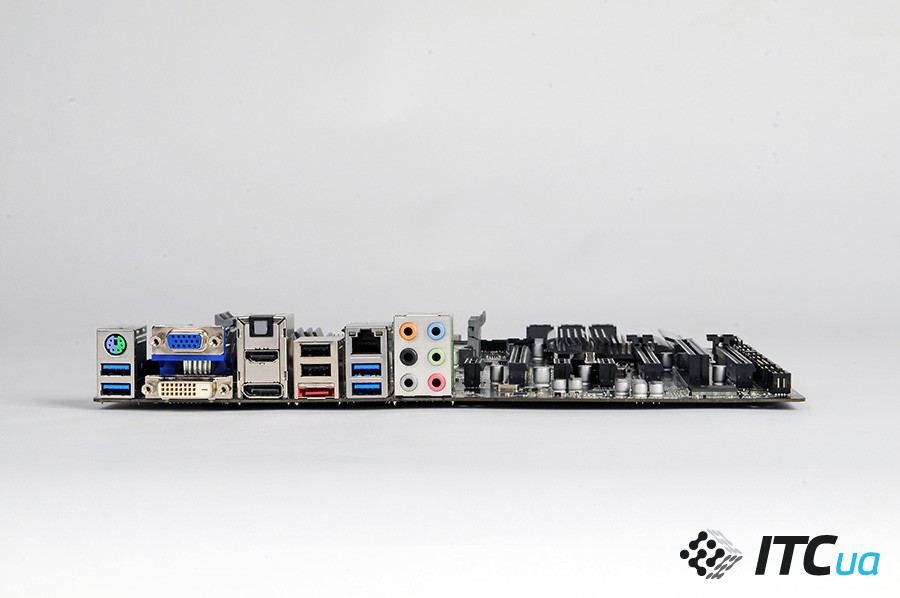
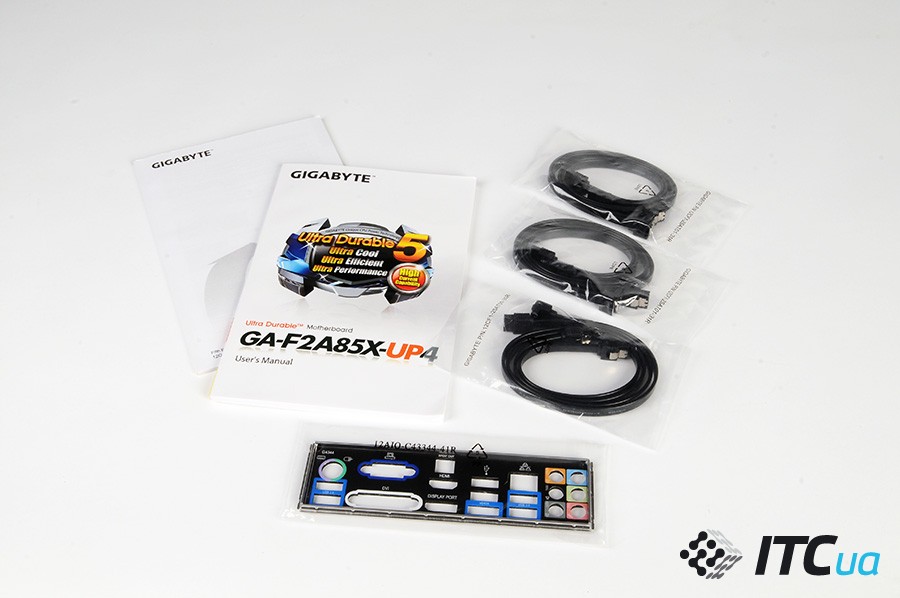

The board complies with the latest specification Ultra Durable 5 which involves the use of high-quality energy-efficient components. Power stabilizer eight-phase (6+2). The power circuit uses powerful IR3550 assemblies, as well as chokes with ferrite cores. A digital controller is used to control the VRM parameters.
The layout of slots for expansion cards is optimal. Three PCI-E x16, the same number of PCI-E x1 and one PCI. The latter does not require an additional controller, since support for this bus is still implemented in AMD chipsets. Considering the number of PCI Express lanes, the nuances of using slots cannot be avoided. The first slot is set to full speed by default. When using two video cards, the first and second slots are switched to x8+x8 mode. The third full-format PCI-E x16 has a bandwidth of x4, while if the nearest PCI-E x1 is used, then the lower PCI-E x16 will also provide data transfer rates at the x1 level. Gigabyte GA-F2A85X-UP4 allows you to fully realize the advantages of the A85X chipset - the model allows you to create a configuration with two video cards based on AMD chips that will work in CrossFireX mode.
On board Gigabyte GA-F2A85X-UP4 there is a gentleman's set of overclockers - power buttons, Reset, Clear CMOS, and status LED. The board is expectedly equipped with two BIOS chips, and the graphic version of the 3D BIOS is used as a UEFI shell, which is conceptually already well known to us from the manufacturer's previous boards.
Of the interesting features of the model, we note the technology Dual Clock Gen. The board has a microcircuit with an additional clock generator (the main one is in the chipset). According to the manufacturer, it allows you to achieve stable operation at higher bus clock speeds (~135-150 MHz), which may be of interest to owners of APUs with locked multipliers who want to boost their processor. Although, of course, given AMD's pricing policy for Trinity chips, it is better for enthusiasts to initially look towards models with the "K" index.
The board has full set video outputs: DVI, HDMI, DisplayPort and D-Sub. In this case, you can simultaneously connect up to three display devices with any combination of interfaces. Note that the DVI port operates in Dual-Link mode, allowing the use of monitors with resolutions up to 2560×1600.
The disk subsystem will allow you to connect 8 drives via SATA 6 Gb / s: seven internal and one using eSATA. As for the peripherals, the user has six USB 3.0 ports. Four of them are implemented using the chipset, two more use an additional Etron EJ168 controller.
In general, the board leaves a rather pleasant impression. A decent set of features for an older solution, nothing superfluous and at the same time a good start for the future.
Performance
To evaluate the possibilities AMD A10-5800K, we have selected worthy opponents for him. First of all, it's a processor AMD A8-3850. This chip differs from the older model of the previous generation APU line (A8-3870K) only by a 100 MHz lower clock speed and a blocked processor multiplier, while the integrated graphics part is used by the most productive Radeon HD 6550D. From the main competitor, a model of the same price category is presented - dual core processor Intel Core i3-3220
During the test of the new APU, we also decided to evaluate the effectiveness of the bundle CPU+GPU in applied tasks, using for these purposes graphics editor Musemage, which uses the resources of the graphics core to perform various operations. The list of stages included the SVPMark benchmark, which also knows how to connect graphics for video processing.

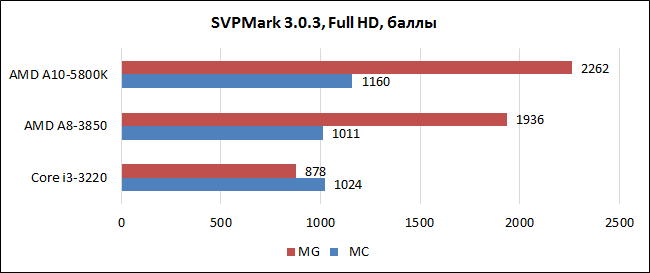
The range of programs interspersed with heterogeneous computing is gradually expanding. Moreover, this is not only synthetic software for tests, but also applied applications. The pace, of course, leaves much to be desired, but there is hope that such developer initiatives will be strongly encouraged by hardware manufacturers. This is the rare case when the interests of both competitors coincide. Intel is also focusing more and more on the performance and capabilities of its integrated video with each successive architectural iteration. chips Ivy Bridge here they have noticeably succeeded in comparison with their predecessors, and in the expected Haswell, the graphics core should receive an even more significant increase in performance. In the meantime, AMD has a much stronger position here.


In 3D synthetics, Trinity has a very solid performance increase of 40-45%. Of course, in the overall standings, the increased performance of the x86 block is also taken into account, but this is not bad after all. 6000 points in 3DMark Vantage is almost the level of the Radeon HD 6570, that is, a discrete graphics card, which is now offered for $50-60. The indicators of Intel HD Graphics 2500 look noticeably more modest against the background of "embeddings" from AMD.
Intel offers separate processor modifications equipped with Intel HD Graphics 4000 graphics. In the case of dual-core models of the Ivy Bridge line, this is the Core i3-3225. It also has an operating clock speed of 3.3 GHz, like the Core i3-3220, but is equipped with a full-fledged graphics module with 16 compute units (the HD Graphics 2500 has only six), although it costs $ 20-25 more. At the time of writing, we did not have such a model, however, in order to include in the review not only the results of the Intel HD Graphics 2500, but also the indicators of the most powerful integrated graphics card to date. Intel Solutions, we used Core i7-3770K. It appears only in gaming tests with embedded video. This will allow a more balanced assessment of the current position and potential capabilities of the integrated GPUs of both companies.
Integrated video capabilities are highly dependent on the performance of the memory subsystem. Let's see how in the case of the A10-5800K throughput RAM affects gaming performance.
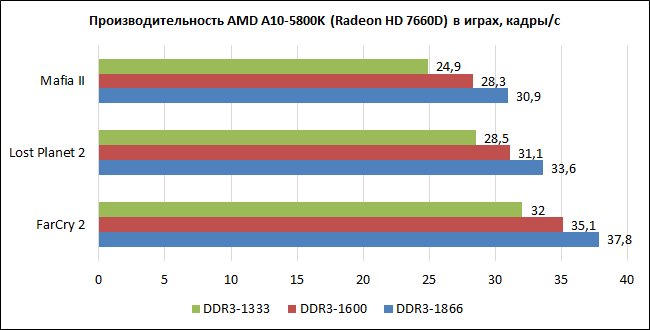
If an integrated video core is used, DDR3-1866 is highly recommended. High-speed or overclocked memory modules to such frequencies will provide an 18-24% increase in performance in games.
Performance with discrete graphics
We also tested discrete graphics platforms using the reference model Radeon HD 7970(925/5500 MHz), which will definitely not become a limiter for processors of this level.
In general, the increase in computing performance of Trinity is relatively small and is on average at the level of 5-15%. Despite the fact that full-fledged Llano computing cores still turn out to be preferable to dual modules in some cases, due to internal architecture improvements, as well as higher clock frequencies, Piledriver-based chips manage to outperform their predecessors. The possibilities of integrated graphics pleased more. A 30% advantage over its predecessor, which before the advent of Trinity was a kind of benchmark in terms of the capabilities of the built-in GPU, inspires optimism.
Energy consumption
Having gained a general idea of the performance of the Trinity APUs, we were also interested in evaluating the power consumption of the new AMD processors. The declared TDP parameter for the A10-5800K is 100 W, let's look at the real performance in typical tasks.
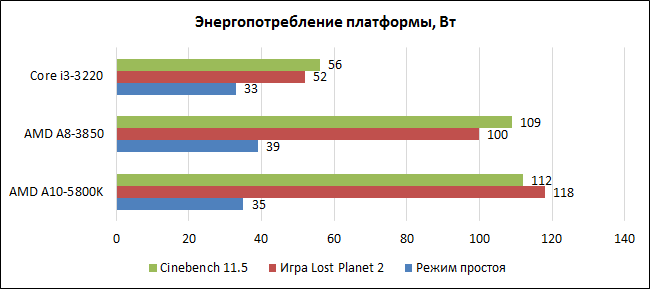
During the load on the computing units (rendering in Cinebench), the consumption of Llano and Trinity is approximately at the same level. But the increase in the power of the graphics core did not go unnoticed. In games where it is the GPU that is more loaded, the power consumption of the A10-5800K is 18 W higher than that of its predecessor. The manufacturing process has remained the same, but higher clock frequencies make themselves felt. At the same time, it is worth noting that in rest mode, in which the processor is often found most of the time, the energy efficiency of the new APUs is higher. However, here it is worth making an allowance for the fact that different motherboards are used for both processors, which can affect the absolute figures.
Dual-core Intel Core i3 as a whole demonstrate exemplary efficiency. The CPU consumes a minimum of energy for computing tasks, but when evaluating performance in games, it is worth considering a significant difference in the speed of solutions.
Results
Platform Socket FM2 and processors Trinity are quite an interesting option for building sufficiently powerful multimedia PCs. Compared to its predecessors, the performance of Piledriver computing units has not increased as much, while the integrated graphics capabilities have been improved by a third, reaching the performance of entry-level discrete graphics cards. On this moment this is a serious advantage of solutions from AMD. At the same time, the range of Trinity chips is exactly the same as that of Llano. Considering the balanced price, they will look very organically as part of inexpensive universal solutions “for everything”. And although in Lately for such tasks are increasingly purchased mobile systems, new APUs in the desktop version will also find their customers.
Test bench configuration
| CPU |
A socket, as you know, is a socket on the motherboard for installing a central processor. Sockets vary in form factor, number of pins, and attachment type. The use of sockets, in principle, is intended to facilitate system upgrades by simply changing the processor. However, the problem is that the release of almost every new processor from AMD or Intel is associated with a transition to a new platform, that is, with the advent of a new socket.
This is clearly seen, in particular, on the example of the latest FM1 and FM2 sockets, designed to connect powerful AMD hybrid processors. The FM1 platform was developed for Llano processors, which were released not so long ago - in mid-2011. However, when developing processors of the new Komodo and Trinity family, AMD decided to abandon the use of the FM1 socket in favor of the new FM2 platform. In this short article, we will try to figure out what this threatens users with and whether there are significant design differences between the FM1 and FM2 sockets.
Platforms FM1 and FM2
Socket FM1 is a 905-pin processor socket. It was developed specifically for AMD Fusion APUs. First of all, we are talking about Liano hybrid processors, which, due to the presence of an integrated graphics core, required not only a new design. AMD's Liano processors were introduced in dual or quad-core variants with support for Direct X 11 GPUs and random access memory type DDR3 1600. All motherboards that came out with a Socket FM1 socket for installing Liano processors adopted the UEFI system instead of the traditional BIOS. In the desktop segment, Liano processors and, accordingly, the FM1 platform debuted on June 30, 2011.
It seemed that the next generation of AMD APUs would also be in Socket FM1. However, the appearance of AMD Llano processors on the market was ambiguously assessed by computer enthusiasts and overclockers, for whom, in fact, the new product was designed. Although the powerful integrated graphics core provided a good level of performance, comparable to the work of junior discrete video cards, however, the Liano processors did not bring the expected increase in frequency potential. And if AMD Llano solutions were quite competitive in the mobile segment, their popularity turned out to be low in desktop systems.
AMD has decided to bet on a new generation of Trinity APUs with more powerful graphics and computing cores. The creation of a more powerful desktop processor required the abandonment of existing platform FM1. This is how the FM2 socket appeared, which is structurally different from FM1 in a slightly different arrangement of contacts.
AMD's new Trinity processors are based on the improved Piledriver architecture and feature powerful integrated graphics. They have a dual-channel DDR3 memory controller with support for operation in modes up to DDR3 1866. One of the main differences between Trinity chips and their predecessor Liano processors is higher clock speeds. If Liano processors managed to get close to the 3 GHz mark, then the older Trinity models can already be overclocked to the mark of 3.8 GHz - 4.2 GHz.
Despite the fact that the older Trinity models have slightly fewer shader units than Llano, this is more than offset by the use of VLIW4 multiprocessor units, faster tessellation processing unit and higher clock speed. The integrated graphics core Trinity has full support for DirectX 11 with ShaderModel 5.0, OpenCL 1.1 and DirectCompute 11. Solutions based on the FM1 socket, by the way, did not provide the ability to use two graphics adapters in the system at once. The new FM2 platform with Trinity processors is aimed at a wide range of users who are interested in building fairly powerful multimedia desktop PCs.
Differences and compatibility of sockets FM1 and FM2
In general, the FM2 socket is a logical continuation of the FM1 platform, so the differences between the two sockets were not too significant. On closer examination, one can see that even appearance socket FM2 has not undergone any radical changes compared to the previous platform. However, these changes still exist. Although the pin layout of both sockets looks similar, the FM2 is missing one of the pins in the center. Thus, if the FM1 processor socket had 905 pins, then the new platform had only 904.
In addition, the so-called "keys", that is, areas without contacts, in Llano and Trinity processors are located in different places on the substrate. Unfortunately, a different location of the "keys" will not even allow you to install the AMDTrinity processor in the old FM1 socket. Some other subtle changes to the FM2 socket have to do with power delivery.
AMD representatives have for a long time given rather evasive answers to the question of whether the FM1 and FM2 platforms will eventually be compatible. This was done, probably, in order not to indirectly reduce the demand for processors with socket FM1. But today it is already known that the new hybrid AMD processors are neither forward nor backward compatible with the FM1 platform.
This means that in order to switch to latest processors Trinity desktop users with AMD Liano processors will need to purchase socket FM2 motherboards. This incompatibility is understandable, because the new AMD processors are based on a completely different architecture, which required a transition to other power subsystems. This circumstance forced AMD to switch to a new Socket platform FM2. However, owners of desktop PCs with the FM1 platform are unlikely to be satisfied with this decision.
FM1 and FM2 socket outlook
AMD has earned the recognition of users not only for its performance and cost-effective solutions, but also for the fact that it has always strived to maintain one design for several generations of its processors. This provided users with the ability to easily and quickly upgrade their PC by purchasing and installing a new processor. So the frequent socket change policy has never been hallmark AMD. That is why the rejection of the FM1 platform actually gave rise to a lot of dissatisfaction among a serious part of AMD product supporters.
With the advent of the new FM2 platform, the company's management de facto recognized the Llano hybrid processors and their accompanying motherboards with the FM1 socket as a "dead end" solution. It is clear that the platform of the previous generation with the lack of the possibility of an upgrade is unlikely to have any success with users. It can be assumed that the FM1 socket, which was released, it would seem, not so long ago, will wait for a short life on the market.
With the FM2 platform, as AMD claims, everything will be different. This processor socket will not become "single serial", as happened with FM1, but will be focused on supporting several future generations of AMD processors. However, given the not very pleasant history with the release of first-generation APUs, potential consumers may have concerns and questions to AMD about whether the FM2 platform is really serious and for a long time. Perhaps in the near future, in connection with the development of new more productive solutions, the company will again have to switch to a completely different processor socket.
Be that as it may, at present a number of manufacturers have already announced the release of socket FM2 motherboards for new AMD processors. These are, for example, the flagship model GA-F2A85X-UP4 from Gigabyte and the Hi-Fi A85W board from Biostar. Everything speaks in favor of the fact that the choice of motherboards with an FM2 connector will become quite wide in the near future.
AMD's decision to release not only APUs based on Trinity, but also a line of "classic" Athlon processors, was greeted with interest. The reasons for it were explained in the July article dedicated to Athlon II X4 for Socket FM1: Although this, of course, is not some kind of breakthrough in performance, as it used to be, however, we already said at the very beginning that this trademark outside the budget market, in principle, does not go. But this family of processors copes with its tasks more often than not, which cannot be said about lines with other names, which usually start their career with false starts. And now we are ready to offer the next generation of processors with a name that has a very good reputation. Albeit, traditionally, intended only for the budget segment, but it is he who is very interesting to many. Therefore, we decided to test new models as quickly as possible. And today we invite you to familiarize yourself with the results.
Most of the theoretical part is not required - as we have already said, these processors are based on the same chip (or chips - if single- and dual-module families are separated by them) as the new APUs: they just have graphics disabled. Accordingly, this is the same Piledriver microarchitecture as in the new ones, the only difference from which is a smaller number of modules and the complete absence of a third-level cache. So the only thing that deserves special attention is the marking: this is Athlon again. We couldn't do without indexes, but Athlon X2 already existed four years ago. But Athlon X4 appeared only now. Why didn't the company come up with a new digital index like Athlon III? We suspect that, firstly, it already smacks of plagiarism, secondly, there is some desire to distance itself from previous families (Athlon II for FM1 rightfully wore its numbers: this is really a processor similar to Athlon II for AM3), thirdly , many have already begun to forget about the previous Athlon anyway, so why the unnecessary suffixes? :) The system of processor numbers has remained the same - three and not four digits (unlike the old Athlon/Phenom or the new APUs and FX). But you can immediately see from it who is xy: the first digit is one more than that of Athlon II. Those. if Athlon II X2 had 200-series numbers, then the new Athlon X2 - 300-e. Athlon II X4 600 and Athlon X4 700 are similar. There is a certain conflict with Phenom II X3 700, but, again, these processors have been gone for a long time, so it is unlikely that anyone will get confused.
Test stand configuration
| CPU | Athlon X4 740 | Athlon X4 750K | A10-5700 |
| Kernel name | Trinity | Trinity | Trinity |
| Production technology | 32 nm | 32 nm | 32 nm |
| Core frequency std/max, GHz | 3,2/3,7 | 3,4/4,0 | 3,4/4,0 |
| 2/4 | 2/4 | 2/4 | |
| L1 cache (total), I/D, KB | 128/64 | 128/64 | 128/64 |
| L2 cache, KB | 2×2048 | 2×2048 | 2×2048 |
| RAM | 2×DDR3-1866 | 2×DDR3-1866 | 2×DDR3-1866 |
| video core | — | — | Radeon HD 7660D |
| socket | FM2 | FM2 | FM2 |
| TDP | 65 W | 100 W | 65 W |
| Price | $81 () | $79 () | $108 () |
The youngest in the family is the Athlon X2 340, but it is unlikely that it will be found often in retail. Including in the form of finished computers - in the budget sector, all manufacturers are trying to save just on a discrete video card, so the A4-5300 is more interesting for them, of which 340 turned out as a result of surgical intervention :) But the older Athlon X4 we just need it: their prices are lower than those of the A8 / A10, but the processor component is similar, i.e. for using discrete graphics on the FM2 platform, they are best suited. The 740th model is generally exactly identical to the A8-5500 with a blocked video core, but the 750K is more interesting - this is the A10-5700 without video, but with unlocked multipliers and an extended thermal package. If it were about Intel processors, the latter would give reason to assume that the Athlon's turbo mode will be a little more aggressive. However, AMD still has simpler frequency control technologies, and the main reason for the existence of devices with different TDPs is the disposal of marriage, so anything can happen. But in order to determine exactly what exactly, we will compare APUs and processors on the same core using this pair.
| CPU | Athlon II X4 651 | Phenom II X4 955 | FX-4100 | Pentium G870 |
| Kernel name | Llano | Deneb | Zambezi | Sandy Bridge DC |
| Production technology | 32 nm | 45 nm | 32 nm | 32 nm |
| Core frequency std/max, GHz | 3,0 | 3,2 | 3,6/3,8 | 3,1 |
| Number of cores (modules) / computation threads | 4/4 | 4/4 | 2/4 | 2/2 |
| L1 cache (total), I/D, KB | 256/256 | 256/256 | 128/64 | 64/64 |
| L2 cache, KB | 4×1024 | 4×512 | 2×2048 | 2×256 |
| L3 cache, MiB | — | 6 | 8 | 3 |
| UnCore frequency, GHz | — | 2 | 2,2 | 3,1 |
| RAM | 2×DDR3-1866 | 2×DDR3-1333 | 2×DDR3-1866 | 2×DDR3-1333 |
| video core | — | — | — | HDG |
| socket | FM1 | AM3 | AM3+ | LGA1155 |
| TDP | 100 W | 125 W | 95 W | 65 W |
| Price | N/A() | N/A(0) | N/A() | N/A() |
For comparison, we also took the older Athlon II X4 for the FM1 platform. On AM3, this line died a long time ago, but it doesn't matter - thanks to the sale of old 45 nm processors, now Phenom II X4 955 can be bought almost at the price of Athlon, so its participation in today's article is a must. As well as the FX-4100 - hitherto the cheapest model for the AM3 +, except for the legacy of the AM3. Moreover, architecturally the processor is similar to the new Athlon, but belongs to the previous generation. But it has a higher starting frequency and has a third-level cache - so let's see what outweighs.
As usual, there are no direct analogues to the new processors in the Intel assortment. Not only because the company offers only dual-threaded processors in the “under $100” segment, but also because the companies have diverged architecturally after several years of running on parallel paths. At the current price, the Pentium G870 is the most suitable for the role of a competitor - the G2120 on Ivy Bridge is somewhat more expensive. More are expected in the near future available models on this crystal, but for now - what is there.
| Motherboard | RAM | |
| FM2 | MSI FM2-A85XA-G65 (A85) | Corsair Dominator Platinum CMD16GX3M4A2666C10(2×1866; 9-10-9-28) |
| AM3+ | ASUS Crosshair V Formula (990FX) | Corsair Dominator Platinum CMD16GX3M4A2666C10 (2×1866/1333; 9-10-9-28 / 9-9-9-24) |
| FM1 | Gigabyte A75M-UD2H (A75) | Corsair Dominator Platinum CMD16GX3M4A2666C10 (2×1866; 9-10-9-28) |
| LGA1155 | Biostar TH67XE (H67) | Corsair Dominator Platinum CMD16GX3M4A2666C10 (2×1333; 9-9-9-24) |
Testing
Traditionally, we divide all tests into a number of groups, and show the average result for a group of tests/applications on the diagrams (for details on the testing methodology, see a separate article). The results in the diagrams are given in points, for 100 points the performance of the reference test system, the site of the sample of 2011, is taken. It is based on the AMD Athlon II X4 620 processor, but the amount of memory (8 GB) and video card (NVIDIA GeForce GTX 570 1280 MB by Palit) are standard for all tests of the “main line” and can only be changed within the framework of special studies. Those who are interested in more detailed information are again traditionally invited to download a table in Microsoft Excel format, in which all the results are shown both in converted points and in "natural" form.
Interactive work in 3D packages
A couple of threads are enough, so the Pentium broke away from everyone (it has the fastest of them), but there is nothing unexpected here. Something else is more interesting - the clear superiority of new AMD processors over the range of last year's (and earlier) collections. Already 740 is enough to overtake absolutely any Athlon II (651 of them is the fastest), and 750K bypasses the FX-4100 and is on the same level with the Phenom II X4 955 - once the flagship of the AMD line. But the A10-5700 is ahead, i.e. the heat pack at work Turbo Core (and in these tests of technology there is where to turn around) does not affect in any way.
Final rendering of 3D scenes
Athlon II and Phenom II lead by a wide margin, which is understandable - two "real" quad-core processors. Pentium is an outsider, since it has not only cores, but also only two calculation threads: that's also understandable. In general, everything is predictable. And the only interesting thing is that the FX-4100, despite the higher frequency and the presence of L3 (this is an important factor in rendering), has a performance equal only to the Athlon X4 740. But the latter is also more energy efficient;)
Packing and unpacking
Here the FX-4100 managed to bounce back, but only thanks to the total cache memory capacity of as much as 16 MiB, which, as we already wrote, is a record for four-threaded processors (by the way, there are no such records in the new generation). But even this allowed only 3% to break away from Athlon X4 750K, where there is no L3 at all! And the 740, where it's not available either, is kept at the level of Phenom II X4 955, where it's available. Well, Athlon of the previous generation is somewhere far away. Pentium is still at the level, fortunately, out of four subtests, three need no more than two computation threads. It will be interesting to see how the state of affairs will change in the new method: after all, WinRar has finally "finished" multi-threaded packaging, which dramatically accelerated the new versions of the latter by multi-core processors, but the "classic" dual cores are simply obliged to "sag" in comparison with the latter.
Audio encoding
Once again, “real” quad-core processors are in the leading positions, a clear outsider is a “real” dual-core processor, and AMD dual-module processors are closer to the first than to the second. Moreover, since the cache memory does not matter here, the improvement of the architecture of 2012 compared to 2011 is clearly noticeable: despite the higher frequency, the FX-4100 significantly loses to the Athlon X4 740. In general, the results of both Athlons here are better than expected. Apparently, this is due to the operation of the memory controller and other components of the "northern bridge" built into the processor: AMD does not yet have a ring bus, so for the APU to function, it is necessary to use a rather complicated scheme of component interaction. And when the GPU was truncated, it was possible to simplify it, which gives a performance gain compared to simply not using the video core (which in our main line of tests is certainly performed for the A8/A10).
Compilation
Another multi-threaded test and understandable results. Only here the value of the cache memory is already extremely high, so the FX-4100 managed to more or less win back. Unless, of course, we consider the results as such only at the level of initially cheaper budget segment processors obtained by a device that still costs more than a hundred bucks.
Mathematical and engineering calculations
On low-threaded code, Athlon II and Phenom II are blown away sharply - "construction equipment" is no worse than them. In the second generation - it's even better. Pentium, of course, goes into the lead in such conditions, but nothing else was expected - this is not the first time we have been testing in these applications, so their needs have been studied well :)
Raster graphics
A mixture of small and multi-threaded tasks again leads to the fact that Trinity in all forms looks good. Pentium, of course, is a little faster on average, but it loses in such time-consuming (and therefore extremely important in practice) disciplines, such as a batch RAW converter. The "classic" Athlon/Phenom X4, on the contrary, are good here, but lose in one-two-threaded applications. A couple of modules in 2012 cope well with those and other loads.
Vector graphics
These applications, on the contrary, strongly "dislike" the new architecture, however, thanks to high frequencies and the presence of a cache shared by a pair of x86 cores, the new Athlons are at least as good as the old ones. And noticeably better than the first generation FX! Also, in general, an achievement.
Video encoding
As we have seen time and again, this group of programs needs multithreading, but not necessarily multicore. However, this one is more useful than others, which is why old quad-core processors are somewhat faster than new “quad-core” ones, but only slightly. Only the Pentium G870 lags far behind all the others, although, as we already wrote, it managed to reach the Athlon II X4 620, which is very good for two "ordinary" cores. However, what the new Athlon X4 show us for the same money is even better.
Office software
The relative failure of the "oldies" and the first FX, the good results of the new Athlon and Pentium are ahead - everything is as expected. For today's main characters, this is more likely a success than vice versa.
Java
But the JVM prefers real kernels, although in the absence of these, it is also able to use SMT. Therefore, the result, let's say, is intermediate - worse than that of old budget multi-core processors, but better than that of a direct competitor: due to the lack of such in Intel's assortment.
Games
From time to time, game engines with good multithreading support appear, but this happens sporadically year after year. Moreover, the bottleneck is very often the video card - a big difference can be seen only with absolutely "unplayable" settings, but this is only the difference between "a lot" and "a lot". There are few exceptions, and in their case, which is curious, not only dual-threaded processors noticeably lose to others, but the difference between four-threaded and quad-core ones is quite large. Although less than in the previous case. And on a more or less wide sample, we get more or less equal results, which is not surprising.
Multitasking environment
The picture is similar to that obtained in other tests with "heavy" multithreading, as expected. Extra threads are still not extra cores, but better than nothing. Especially since So Loading an ordinary home computer is not so easy in practice, so the loss of the new generation to the old one is only nominal. We win against the direct competitor - and it's good.
Total
Perhaps the most interesting result is the similarity of Athlon X4 740 and FX-4100 in the overall result. Despite the higher frequencies of the latter and the presence of a capacious cache, only its "leadership" in TDP is unambiguous. That's it! Actually, we already wrote about this in the FX-8350 review: if instead of Bulldozer, a Piledriver appeared immediately, claims to new architecture AMD would be much smaller. Or maybe it wouldn't have happened at all.
And the confrontation between Phenom II X4 955 and Athlon X4 750K also speaks volumes. Of course, the first processor turned out to be a little faster due to noticeable advantages in multi-threaded code or where cache is important, but in many mass applications it lags behind and noticeably lags behind. But this is initially a much more expensive development, aimed at the upper segment of the market and got into the budget sector only because somehow old processors need to be sold. Trinity's die size is only slightly smaller, of course, but most of it is occupied by the GPU. Those. Athlon X4 itself is a by-product that can be used for defective APUs. In general, these AMD processors cost even less than nothing - otherwise, these crystals would have to be thrown away altogether, otherwise they can be sold. If the predictions about the displacement of other platforms in favor of FM2 turn out to be correct, then here they are - solutions for the budget segment, but with discrete graphics. For mass deliveries, you can simply make another design - already initially without a graphic part. Here it will be, by definition, compact and cheap. And, as you can see, quite productive.
Moreover, Intel is not yet aiming at direct competition in this class. Pentiums are good on average (and Ivy Bridge models are even better), but they lag far behind in multi-threaded applications. In practice, this is not fatal, but for six years now there have been hopes among users that over time all applications will become those that AMD successfully exploited back in the days of Athlon II X2 and X3 and is not going to abandon them in the future. Moreover, the Athlon X4 (like the FX-4000) are at least called quad-core processors, while Intel has had them for many years only in the segment above $150. The only difference is that they are really quad-core, but who will pay attention to this with a twofold difference in price? The closest ideological relative of AMD's dual-module models is Core i3, but they cost more than $100 and are not positioned as quad-core.
In general, everything about the new Athlon is good. Except for one small drawback inherited from Athlon II for FM1 - these are not quite universal processors. Unlike its predecessors, which could also be used in a system with discrete graphics, and (in order to save money) installed on a board with an integrated graphics core. Now there are no options to choose from; of all the testers, it is these three models (651, 740 and 750K) and integrated graphics that live in non-overlapping worlds. Of course, one can object that the point of intersection of these worlds is "full" APUs, but... The price of the solution and the performance of the processor part matter. Everything is very good with the first one in A4 / A6, but the second one does not shine in single-module processors. And the A8/A10 graphics are redundant for those who don't play games and insufficient for "serious" gamers, and they are more expensive from Intel, a surgical operation improves something compared to a simple "non-use" of the GPU) - already just at the level of Core i3. In the latter, the graphic core is even more insufficient from the point of view of the gamer (assuming, of course, the existence of sturgeon freshness, different from the first), but it is also for everything else - it will do. And Celeron and Pentium also have something, yes. Those. just from this side, Athlon has a very weak spot. Which could well be fixed by giving it a minimal GPU. Even if only one SIMD block is already better than the AM3 + chipset graphics and no worse than the lower versions of HD Graphics, but still will not cause competition with the APU. But it will make processors truly universal.




